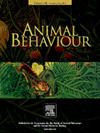Hainan frilled treefrogs adjust spectral traits to increase competitiveness when perceiving conspecific disturbance odours
IF 2.3
2区 生物学
Q2 BEHAVIORAL SCIENCES
引用次数: 0
Abstract
Chemical communication is regarded as the most ancient and widespread form of communication, playing a crucial role in various individual activities such as foraging, mating and defence. Nevertheless, chemical communication in anurans (i.e. frogs and toads) has received less attention, as individual decision making in male–male competition and female choice is predominantly influenced by acoustic signals. In recent years, there has been increasing evidence indicating that chemical cues can affect male–male competition behaviours in anuran species, including aggression and call activity. However, few studies have investigated whether chemical cues affect the spectral traits of acoustic signals, which are important for attracting potential mates. In the present study, we investigated variation in the dominant frequency of advertisement calls in Hainan frilled treefrogs, Kurixalus hainanus, comparing the calls of males vocalizing alone to those in the presence of conspecific odours. Our results showed that males with a higher dominant frequency significantly decreased their frequency when exposed to conspecific odours, while those with a lower frequency increased it. Further analysis revealed that the dominant frequency of advertisement calls during the stimulus period was closer to the average level than that during the spontaneous period, a trend observed only in the disturbance odour group. This adjustment may serve to maintain attractiveness to females in the face of potential predation risk. Overall, our study provides evidence that conspecific chemical cues affect the spectral traits of frog vocalizations and has an implication for understanding how males balance survival and reproduction by adjusting their calling strategies.
海南褶边树蛙在感知同种干扰气味时调整光谱特征以增加竞争力
化学通信被认为是最古老和最广泛的通信形式,在各种个体活动中起着至关重要的作用,如觅食、交配和防御。然而,无尾动物(如青蛙和蟾蜍)的化学通讯受到的关注较少,因为雄性竞争和雌性选择的个体决策主要受声音信号的影响。近年来,越来越多的证据表明,化学线索可以影响无尾猿物种的雄性竞争行为,包括攻击和呼叫活动。然而,很少有研究调查化学线索是否会影响声学信号的光谱特征,而声学信号对于吸引潜在伴侣很重要。在本研究中,我们研究了海南褶皱树蛙(Kurixalus hainanus)广告叫声的优势频率的变化,并比较了雄性单独发声与同种气味存在时的叫声。我们的研究结果表明,当暴露于同种气味时,优势频率较高的雄性显著降低了它们的频率,而优势频率较低的雄性则增加了它们的频率。进一步的分析表明,在刺激期间,广告叫声的主导频率比自发时期更接近平均水平,这一趋势仅在干扰气味组中观察到。这种调整可能有助于在面对潜在的捕食风险时保持对雌性的吸引力。总的来说,我们的研究提供了证据,表明同种化学线索会影响青蛙发声的光谱特征,这对理解雄性如何通过调整它们的叫声策略来平衡生存和繁殖具有重要意义。
本文章由计算机程序翻译,如有差异,请以英文原文为准。
求助全文
约1分钟内获得全文
求助全文
来源期刊

Animal Behaviour
生物-动物学
CiteScore
4.60
自引率
8.00%
发文量
236
审稿时长
10.2 weeks
期刊介绍:
Growing interest in behavioural biology and the international reputation of Animal Behaviour prompted an expansion to monthly publication in 1989. Animal Behaviour continues to be the journal of choice for biologists, ethologists, psychologists, physiologists, and veterinarians with an interest in the subject.
 求助内容:
求助内容: 应助结果提醒方式:
应助结果提醒方式:


